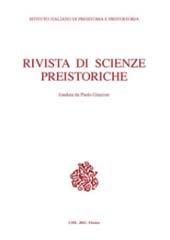Gli alari nell'abitato dell'età del Bronzo di Mursia (Pantelleria) : analisi dei modelli e comparazioni tra Sicilia e Mediterraneo orientale
P. 1-66
The study of objects and tools related to fire in the Bronze Age has rarely been discussed in an extensive and systematic analysis, both in Sicily and the wider Mediterranean context. This paper aims to investigate the use of clay andirons in cooking practices, starting from a typological and functional evaluation of the specimens found at the Bronze Age settlement of Mursia on the island of Pantelleria, TP (1750-1450 BC). The andirons, here intended as movable clay objects used in pairs to support a ceramic vessel over a fireplace, constitute a highly diagnostic element for interpreting cooking traditions, from both a technological and cultural point of view. The abundance of clay andirons at Mursia points to a systematic use of these objects in activities related to fire, especially during the recent phases of occupation of the settlement, corresponding approximately to the middle of the 2nd millennium BC.
Besides the functional value of these objects, the presence of different types of handles and decorations can be interpreted as a distinctive cultural choice expressed by the inhabitants of Mursia in the domestic activities related to the preparation and consumption of food. The study of clay andirons of Mursia offers the opportunity to carry out a comparative analysis of similar fire supports in Sicily and neighbouring islands. Three main models of clay andirons have been identified, taking into account the general morphology and other functional and stylistic attributes, according to selected parameters: the type of andirons documented at Mursia shows a semicircular base with a hollow central body and two wide semielliptical projections to the front, while the other two models, attested in Sicily and in the smaller islands, are characterized by a hollow truncated coneshaped body with a circular or sub-rectangular base and a pair of conical or trapezoidal projections on the top.
An extension of the research for possible parallels on a long-term and interregional scale outside of Sicily is carried out with the aim of understanding the circulation of shared models and, at the same time, to highlight distinctive technological and cultural patterns among Mediterranean communities. This wide-range exploration has allowed to identify different types of andirons and fire supports and to reconstruct their distribution between the 4th and 2nd millennium, tracing possible inspiration in artifacts found in the Transcaucasian regions and in the Near East. The "horseshoe-shaped" fire stands, used as single portable hearths, are mainly attested in Anatolia, in Syria, in the Southern Levant and in Cyprus, while clay andirons, used in pairs or in groups of three, are well-documented in some Transcaucasian sites, in the Aegean and in Egypt.
Although there are no close parallels, these last models (the Aegean and the Egyptian) can be regarded as possible reference points for the clay andirons documented respectively in Sicily and at Pantelleria. [Publisher's text]
Lo studio dei manufatti mobili legati all'uso del fuoco nell'età del Bronzo raramente è stato trattato in modo esaustivo e sistematico, sia per la Sicilia che per il più ampio scenario mediterraneo. Il presente contributo affronta il tema delle modalità di cottura mediante alari fittili, con una proposta di inquadramento tipologico e funzionale degli esemplari rinvenuti nell'insediamento di Mursia a Pantelleria, TP (1750-1450 a.C.). Gli alari, intesi come dispositivi mobili usati in coppia per sostenere un contenitore ceramico sul fuoco, costituiscono un sistema per la cottura degli alimenti altamente diagnostico da un punto di vista sia tecnologico che culturale. L'abbondante documentazione di alari nell'abitato di Mursia mostra un utilizzo sistematico di questi dispositivi a partire dalle fasi avanzate dell'abitato, corrispondenti alla metà del II millennio.
Accanto alle esigenze funzionali, la scelta di caratterizzare gli alari con impugnature e decorazioni differenziate sembra indicare una peculiare espressione della comunità di Mursia nelle attività domestiche connesse alla preparazione e al consumo dei cibi. L'analisi degli alari di Mursia ha offerto l'opportunità di effettuare un'indagine comparativa dei modelli di sostegni da fuoco esistenti in Sicilia e nelle isole limitrofe. Assumendo come parametri fondamentali la morfologia generale e gli attributi funzionali e accessori (appendici, impugnature, eventuali decorazioni), è stato possibile individuare tre modelli principali di alari: se il modello di Mursia presenta una base semicircolare con corpo centrale cavo e due ampie appendici anteriori, gli altri due modelli, attestati in Sicilia e nelle isole limitrofe, presentano un corpo cavo troncoconico con base circolare o subrettangolare e una coppia di appendici coniche o trapezoidali protese in avanti sulla parte sommitale.
Al di fuori della Sicilia, l'estensione della ricerca su scala interregionale ha mirato a verificare l'eventuale circolazione di modelli condivisi e, al tempo stesso, ad evidenziare differenze tecnologiche e culturali significative tra le diverse comunità mediterranee. L'esplorazione effettuata ha consentito di individuare diversi tipi di sostegni da fuoco e di illustrare la loro distribuzione tra il IV e il II millennio, rintracciando possibili origini nelle regioni transcaucasiche e vicino-orientali. Se in Anatolia, in Siria, nel Levante meridionale e sull'isola di Cipro sono attestati prevalentemente i sostegni da fuoco a “ferro di cavallo”, funzionanti come fornelli portatili singoli, in alcune località transcaucasiche, nell'Egeo e in Egitto, sono invece diffusi dispositivi equiparabili ad alari, utilizzati cioè a coppie o a gruppi di tre esemplari.
Nonostante non ci siano confronti puntuali, sembra che questi ultimi abbiano potuto costituire il modello di riferimento per i diversi tipi di alari documentati rispettivamente in Sicilia e a Pantelleria. [Testo dell'editore]
Ist Teil von
Rivista di scienze preistoriche : LXXI, 2021-
Artikel aus derselben Ausgabe (einzeln erhältlich)
-
Informationen
DOI: 10.32097/1149
ISSN: 2282-457X
KEYWORDS
- Alari fittili, sistemi di cottura, Pantelleria, Mediterraneo, età del Bronzo
- Clay andirons,cooking methods, Pantelleria, Mediterranean, Bronze Age.



